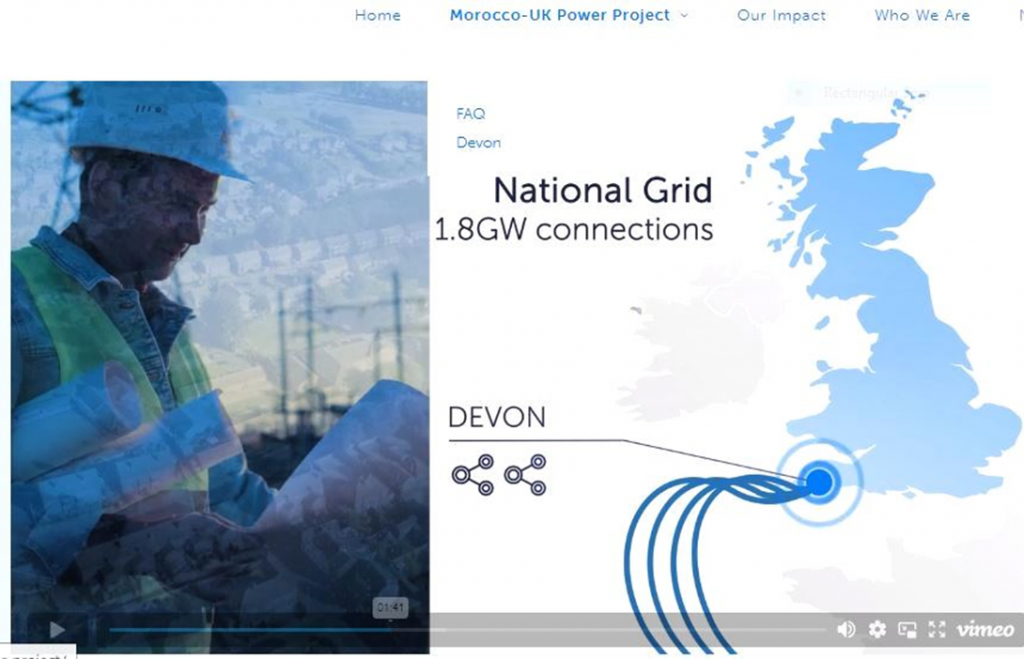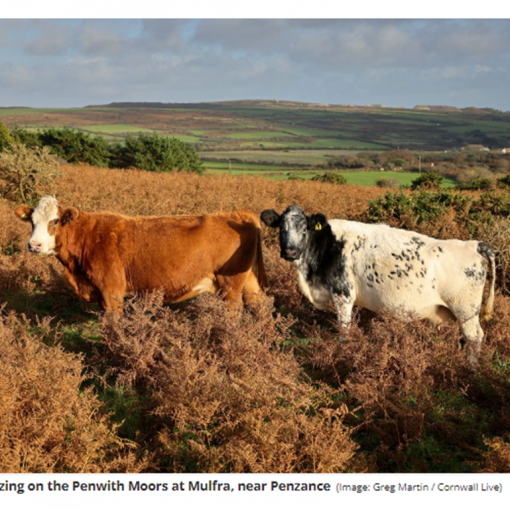6th October
Furriners and Foragers, some thoughts on self-sufficiency. Then the usual medley of topics, ranging from BIG investments (HS2, Moroccan Solar & latest Tidal), to a modest scheme called LAEP, and the small, but exciting LEAF at Lostwithiel.
If you are not familiar with Cornish dialect you won’t know what I am talking about here – it was summer 2022 when we welcomed a couple of ‘furriners’ from Middle England, (was it Hampshire or Surrey?) to live at the bottom of our hill. Now, in case you didn’t guess, here is the definition – Furrin. Furriner………… Foreign. Foreigner e.g. not born in Cornwall.
As I have got to know these people it has often crossed my mind to wonder, why would they have taken on a place of such antiquity and decay? On one side they have remains of a medieval corn mill, on the other a massive area of tumble-down china clay sheds. The farmhouse they moved into dates back through many centuries as a centre of tin processing. So why are they tackling this?


The answer is that they believe the world is going to ‘hell in handcart’, with so many potential risks on the horizon, they think it can only make sense to become entirely self-sufficient, off-grid. For energy, so far, they have installed a goodly array of solar power and were poised to resurrect the old leat and water turbines, but then found they didn’t even have reliable clean drinking water – thus their water plans are going to take a while yet. Their other journey is into growing food for their own table, which has started well, primarily within a greenhouse. I now have a suggestion of something else to add to their plans; I only discovered it last weekend – foraging and ‘plants for a future’.
It was a very damp September Sunday, and I joined a dozen or so other visitors at an open day of Plants for a Future Community Woodland, near St Veep. This amazing place was conceived and created by Addy and her husband, Ken, who are convinced that variety in the choice of plants we grow for food is key to giving us the resilience to meet the challenges of climate change.

Addy says ‘There are tens of thousands of edible food plants in the world, but most of the food eaten comes from just three species – corn, wheat and rice – all of which are themselves vulnerable to climate impacts.’ I haven’t time in this blog to expand on those 3 staple crops, but can see that I will explore it (as a topic of huge importance to the world) sometime soon.
As she led us through the jungle of growth, Addy was constantly leaning into trees, bushes and ground-cover plants to pick a handful of leaves and/or berries, which she offered around for us to chew on. She did not pretend that all these strange tastes would be found palatable, in fact it was remarkable how widely different the responses were. Some thought sharp and sour flavours delicious, whilst others swiftly spat them out! I confess to being very cautious myself, but I had a good go at Szechuan Peppers, which I have always enjoyed using in Chinese cuisine, but in this fresh-from-the-tree version were so pungent!
Find out more at http://plantsforafuture.theferns.info



Decaisnea Fargesii – A hardy shrub from the Himalayas with blue fruits. The pulp is edible and tastes like watermelon. Peel and seeds are poisonous. The blue sausage shrub is a hardy shrub that initially grew at an altitude up to 3000 meters high in the Himalayas, with blue-green leaves and purple branches. (The taste was quite watery and sweet, yes like a melon).
I think there is scope for a much bigger write-up of foraging too, so if any reader would like to contribute on this I would be delighted to receive and send out your thoughts.
HEY BIG SPENDERS! Flip-Flopping over HS2
By the time of Wednesday’s announcement that HS2 would not be built to Manchester, I imagine I was not alone feeling utterly bored and again frustrated by this fiasco. What I was not aware, until someone shared a very short video with me, was that our flip-flopping to and fro and inability to control big budgets has become a main theme of teaching the folly of Democracy, in Chinese Universities! Boris will explain:-
according to the Chinese ‘It is a story that tells you all you need to know about political weakness, about chopping and changing, and craven short-termism.’
https://www.dailymail.co.uk/news/article-12575763/BORIS-JOHNSON-not-scrap-hs2-manchester-leg.html
It isn’t clear to me what the most recent total price tag prediction was, significantly above £100bn anyway. Delivering a reduction of 30 minutes on the journeys north from London hardly seemed like a great reward for so many £s investment to me. Remains to be seen whether the sundry bits and pieces of expenditure proposed instead will be better value.
What does China think of this one?
By comparison the price tag here is a modest £20bn. The idea is to set up enormous solar and wind production in Morocco and transfer the power to consumers in the UK via a new sub-sea set of cables. https://xlinks.co/morocco-uk-power-project/
HVDC High Voltage Direct Current, delivers 3.6 GW for over 20 hours per day.
4 x 3,800 km length sub-sea cables will deliver 8% of Britain’s electricity needs for half the cost of Hinkley nuclear.


https://sifted.eu/articles/xlinks-morocco-uk-electricity-cable
In a world run on renewable energy, giant cables will criss-cross the globe, bringing solar and wind power from one country to another. These green arteries will fill the gaps in places when the sun isn’t shining and the wind isn’t blowing.
There are at least nine of these cross-border electricity cables, known as interconnectors, planned in Europe. A 250km line from Germany to Sweden; another, 760km from Denmark to the UK. But the cable that British company Xlinks wants to build will put all others to shame.
Backed by UK energy business Octopus Energy, Xlinks plans to bring solar power from sunny Morocco to cloudy Britain with HVDC (high voltage direct current) undersea cables, which will run 3,800km — the longest such cables in the world. For the small sum of £20bn, the project could deliver 8% of the UK’s energy demand, enough to keep the lights on in 7m homes.
But there are a lot of hurdles to clear before an interconnector can be switched on; some projects have failed over a lack of capital. And others have died on the planning table thanks to the lack of factories that can actually build such a big cable.
“This is a crazy project,” says Simon Morrish, CEO of Xlinks. How can he be the one saying that??
What others say
NGOs have raised fears about the impacts of renewable energy projects on Morocco, particularly the risk of them fuelling conflict in the disputed Western Sahara. There are also questions over their contribution to water scarcity — solar parks need lots of water to clean panels. Xlinks says there are no people living on the land it plans to use. It also says it’s working on water desalination projects in the area and that it will leave a net surplus of water (they do not say ‘along with the usual problems associated with desalination!’).
Predicted costs, £45m raised… of £20bn
Apart from the massive gap between funding raised and the total that will be needed, the other main challenge facing interconnector projects like Xlinks is that there are very few manufacturers equipped to make the cables themselves. To solve that, they have set up a separate company, XLCC, to manufacture cables. They’ve secured a site in Scotland for the factory, set to be the UK’s first HVDC (High Voltage Direct Current) manufacturer.
Appetite for interconnector manufacturing is on the rise and, beyond the Morocco-UK cable, XLCC wants to position itself as central to the industry.
“This sets the stage for long-distance cables crisscrossing the globe, just like data cables do today,” says Morrish. “There’s no reason we can’t do this between the UK and the US, and all over the place.”
WHY IS NOBODY CHALLENGING THIS? What about the Energy Security here? It would be precarious, wide open to sabotage. Yes, I see that it feels more attainable than newer, more experimental options and -at present – looks like better value too.
Marine Renewables
On Thursday 5th’s evening news, the BBC’s Justin Rowlatt reported that tidal, which is being considered as a realistic option at last, is way more expensive ‘even more than nuclear’, but the government is now giving some financial incentives via a scheme called CfDs or Contract for Difference Scheme (find a full explanation on the government website). The summing up is by Prof Danny Coles in Plymouth … am I allowed to say ‘Told you so?!’ I reported about Danny’s work in Blog 24, 11 weeks ago! Please forgive the slightly bumpy transitions, I had to edit down severely to get it to upload.
To round this week off I would like to consider some words beginning with L.
Local Area Energy Plans – Consultations around Cornwall
At the start of the previous week I had journeyed to the town of Bodmin, for a session of ‘consultation’ by our main Cornwall Council, with the following ambition: –
You can help shape ambitious new plans to decarbonise energy systems in Cornwall and the Isles of Scilly, in order to help the region reach Net Zero and work towards energy security. The project will look at how energy is used, supplied and managed. 25 Sept 2023
My expectation was that we would be talked at but no. It was simply a chance to wander through a big room, set out with displays and a number of council officers and external consultants standing by to exchange ideas, leading to a table for post-it notes. I spent quite a while with the consultant, Louis from City Science. Their track record shows extensive experience of gathering data and making recommendations on ‘Active Travel’, always for cities. Presumably a rural county will challenge their standard assumptions!
My conversations with Louis and his colleagues were interesting, though I am not convinced any of my suggestions were recorded and will be taken seriously! You can probably guess, my most important ideas were all about HVO (Hydro-treated vegetable oil) and having put them across as clearly as I could, I immediately also wrote them up into a letter for Labour party councillors and one MP, in the naïve hope that someone might take them to the Conference next week. (PS Sorry to confess that I do have a clear left-facing preference, going into the next election, but it will never prevent me sharing other perspectives.)

John runs Carley’s Organics and Chacewater Energy events, such as this one on Saturday 14th October https://www.eventbrite.co.uk/e/energy-efficiency-day-tickets-687414062967
(first 30 get a free Chacewater Bakery veg pasty!)
A few days later, Pat Smith (AKA Action Nan) forwarded info on another Council scheme, this one labelled LNRS (LOCAL again), Nature Recovery Strategy asking for ‘significant input from key stakeholders embedding collaboration and co-production‘. I am really happy to see this developing trend, but now we also want it to happen for Heritage.
Lostwithiel & Half Term
From LAEP, Cornwall -wide, which I will continue to report on if anything of value transpires, the final acronym is LEAF Lostwithiel Environmental Action Forum https://www.facebook.com/groups/LostLEAF/?locale=en_GB
I only became aware of this group recently, so was pleased to see an opportunity to go and meet their team at an end-of-month ‘Repair Café’ on Saturday. The room was packed, with queues of patiently waiting customers, indeed my own items never quite made it into the magical mender’s hands! Many pieces were electrical and sadly – so far as I could tell – the success percent for those was not great. Anything physical/mechanical had a better chance of a positive result. I really liked the atmosphere, so positive and friendly and wonder how unusual this is? Do you have the equivalent of LAEP or LEAF in your area?

HALF TERM 4 CLIMATE HOPE – BOOK NOW, ONLY 20 PLACES PER SESSION AVAILABLE
https://www.eventbrite.com/e/october-half-term-harvest-4-climate-hope-tickets-725573990337
Next week, with this major Half Term project looming and many aspects to co-ordinate, I will be running a textiles and crafts session, here at Meadow Barns on Saturday 14th, helped by some volunteers, and I plan to save up the photos and describe progress for a slightly later than usual sharing of blog, (Saturday night or Sunday). I feel confident there will be some wonderful stories of how textiles and crafts can bring Climate messages to life in vivid colours, with stories of the ‘Knit for Climate Action’ project world-wide and the WI Climate productions as described here – Cornwall Climate Ambassadors took advantage of the wonderful WI marquee at the Royal Cornwall Show to display their ‘We Can All Make a Difference’ banner, and hand out hundreds of copies of their booklet Green Tips:- Coping with Climate Change. Congratulations on that project and Big Thanks for coming on board!





2 thoughts on “GF Blog 23 – Week 36”
Thanks for another bright read Caroline, keeping lifting folk and prodding for action. Hope you’ve seen our new ‘have a coffee and cake action place mat’ ? https://climatevision.co.uk/wp-content/uploads/2023/05/CV-A3-pledge-place-mat-R2AW.pdf We have copies if anyone wants ones and a new children’s one – yet to be uploaded – drekly
Very glad you saw this last few Luci, thanks! The Plants for Future Food place is amazing!
I wasn’t aware of your pledges place mats, but very happy to share. Is it OK to wait for the children’s one and promote both at once? Best wishes Caroline